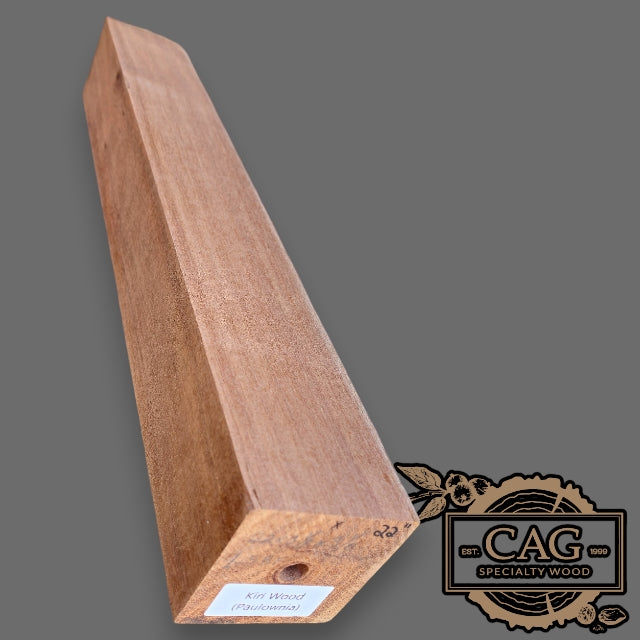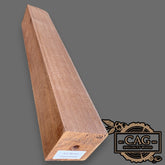
Kiri Wood (Paulownia)
|
Common Name(s): Paulownia, Royal Paulownia, Princess Tree, Kiri Scientific Name: Paulownia tomentosa Distribution: Native to eastern Asia; also planted in eastern North America Tree Size: 30-65 ft (10-20 m) tall, 2-4 ft (.6-1.2 m) trunk diameter Average Dried Weight: 18 lbs/ft3 (280 kg/m3) Specific Gravity (Basic, 12% MC): .25, .28 Janka Hardness: 300 lbf (1,330 N) Modulus of Rupture: 5,480 lbf/in2 (37.8 MPa) Elastic Modulus: 635,000 lbf/in2 (4.38 GPa) Crushing Strength: 3,010 lbf/in2 (20.7 MPa) Shrinkage: Radial: 2.4%, Tangential: 3.9%, Volumetric: 6.4%, T/R Ratio: 1.6 |
Kiri Wood (Paulownia)
Key Points
- Kiri is a fast-growing softwood tree native to China and Japan.
- The wood has a fine, uniform grain and texture that can closely resemble the appearance of Sapele, a popular cabinet and furniture wood.
- Kiri wood is lightweight, soft, and easy to work with. It has a light yellowish-brown color that darkens over time.
- Key similarities to Sapele include the straight, uniform grain pattern and the reddish-brown hue.
- Kiri is sometimes used as a substitute for Sapele in applications like interior paneling, furniture, and musical instruments.
- However, Kiri is generally less dense and durable than true Sapele, which is an African hardwood.
Color/Appearance: Heartwood typically a pale grayish brown, sometimes with a reddish or purplish hue. Pale white sapwood not clearly demarcated from heartwood. Overall appearance (both the wood and the tree itself) is not too unlike Catalpa, another lightweight and porous hardwood.
Grain/Texture: Grain is generally straight, with a coarse, uneven texture. Very large pores give Paulownia a striped, porous look.
Endgrain: Ring-porous, occasionally semi-ring-porous; 3-5 rows of very large earlywood pores, large to small latewood pores; tyloses common; narrow to medium rays visible without lens, normal spacing; parenchyma winged, lozenge, confluent, and marginal.
Rot Resistance: Reported to be durable regarding decay resistance, with decent weathering characteristics, though susceptible to insect attack.
Workability: Given its straight grain and light weight, Paulownia is extremely easy to work. However, due to a high silica content in some trees, the wood can have a strong blunting effect on cutting edges. Takes a wide variety of glues, stains, and finishes well.
Odor: No characteristic odor.
Allergies/Toxicity: Besides the standard health risks associated with any type of wood dust, no further health reactions have been associated with Paulownia. See the articles Wood Allergies and Toxicity and Wood Dust Safety for more information.
Pricing/Availability: Paulownia is seldom offered for sale in the United States, though it’s actually grown on plantations and exported to Japan, where demand for the wood is much higher. Prices are likely to be high for a domestic species.
Sustainability: This wood species is not listed in the CITES Appendices or on the IUCN Red List of Threatened Species.
Common Uses: Plywood, veneer, furniture, boxes, millwork/siding, musical instruments (electric guitar bodies), clogs, carvings, and other small specialty items.
Comments: The other Balsa. Paulownia is used in applications where a lightweight (yet proportionately strong) wood is needed. It’s widely used in Japan for construction of the koto (a stringed musical instrument), as well as other household items, where the wood is referred to as Kiri. Paulownia is one of the fastest growing trees in the world, capable of growth rates of well over seven feet per year as a seedling! But while it’s highly appreciated and cultivated in Asia, Paulownia has come to be considered an invasive species in the United States.
Paulownia was named after Queen Anna Pavlovna of Russia (1795-1865), and is sometimes called Royal Paulownia or Princess Tree.
Kiri Wood (Paulownia)
4050 Old Cornelia Hwy
Gainesville GA 30507
United States
Wood Calculator Section
Need Help Figuring out how much you need ?
One Board foot = 144 Cubic Inches
Example: If you need a piece of wood 12 inches wide, 1 inch thick and 24 inches long, that is equal to 2 board feet.
12 inches x 1 inch x 24 inches = 288 inches. 288/ 144 = 2 board feet


